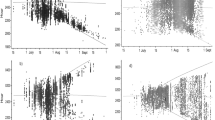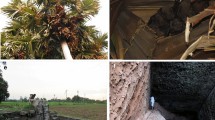Summary
-
1.
We investigated the influence of light on the activities of two species of fruit bats: one, Rousettus aegyptiacus lives in caverns and the other, Eidolon helvum, lives in trees.
-
2.
Both Rousettus and Eidolon are dark active and show a monophasic activity pattern. The daily period of main activity for Eidolon wa at the beginning of dark time whereas Rousettus showed its main activity during the second half of dark time.
-
3.
When the dark phase was prolonged (LD 4∶20) there was almost no alteration of the activity period; when it was shortened (LD 22∶2) the activity period could be compressed to two hours.
-
4.
In continuous light Rousettus as well as Eidolon exhibited a circadiane activity rhythm. The period for Rousettus lasted more than 24 hours (Fig. 15), for Eidolon less than 24 hours (Table 5).
-
5.
After shifting the dark phase the time of resynchronization depended upon the direction of shifting and upon the difference of light intensity between light and dark phase.
-
6.
With small light intensities Rousettus could be synchronized by an intensity difference of 0.006 lx only (LD 12∶12; 0.041∶0.035 lx). With high light intensities a desynchronization could be partly observed in LD of 31∶3,9 lx.
-
7.
With an LD having constant intensity in the light phase and having varied intensities in the dark phase, and also with an LL having different intensities the flying bats investigated showed light dependent maxima of activity (Figs. 14 and 15). The α∶ϱ relation complied only with the circadiane rule of Aschoff whereas length of period and phase difference were not clearly correlated with light intensity.
-
8.
The dark inhibition of the activity of dark active animals was not primarily related to reduced orientation but to inhibition by small light intensities. This finding was discussed.
Zusammenfassung
-
1.
Es wird untersucht, welchen Einfluß das Licht auf die Aktivität einer höhlenbewohnenden (Rousettus aegyptiacus) und einer baumbewohnenden Flughundart (Eidolon helvum) hat.
-
2.
Rousettus und Eidolon sind dunkelaktiv und haben ein monophasisches Aktivitätsmuster. Bei Eidolon liegt die tägliche Hauptaktivität zu Beginn, bei Rousettus in der zweiten Hälfte der Dunkelzeit.
-
3.
Bei verlängerter Dunkelphase (LD 4∶20) ändert sich die Aktivitätszeit kaum; durch eine Verkürzung der Dunkelphase (LD 22∶2) kann sie auf 2 Std komprimiert werden.
-
4.
Rousettus und Eidolon zeigen im Dauerlicht einen circadianen Aktivitäts-rhythmus, dessen Periodenlänge bei Rousettus über (Abb. 15), bei Eidolon unter 24 Std liegt (Tabelle 5).
-
5.
Die Resynchronisationszeit nach einer Verschiebung der Dunkelphase ist abhängig von der Richtung der Verschiebung und von der Intensitätsdifferenz zwischen Licht- und Dunkelphase.
-
6.
Im Bereich geringer Beleuchtungsstärken kann bei Rousettus noch ein Intensitätsunterschied von 0,006 lx synchronisierend wirken (LD 12∶12; 0,041∶ 0,035 lx), bei hohen Beleuchtungsstärken tritt zum Teil im LD von 31∶3,9 lx eine Desynchronisation auf.
-
7.
Im LD mit gleichbleibender Helligkeit in der Lichtphase und variierter Beleuchtungsstärke in der Dunkelzeit und im LL verschiedener Beleuchtungsstärken zeigen die untersuchten Flughunde beleuchtungsabhängige Maxima der Aktivitätsmenge (Abb. 14 und 15). Der Circadian-Regel Aschoffs folgt nur das α∶ϱ-Verhältnis; Periodenlänge und Phasendifferenz sind nicht eindeutig mit der Beleuchtungsstärke korreliert.
-
8.
Es wird diskutiert, daß die Dunkelhemmung der Aktivität dunkelaktiver Tiere nicht primär auf ein vermindertes Orientierungsvermögen zurückgeht, sondern daß geringe Beleuchtungsstärken direkt hemmend auf den Organismus wirken.
Similar content being viewed by others
Literatur
Aschoff, J.: Exogenous and endogenous components in circadian rhythms. Cold Spr. Harb. Symp. quant. Biol. 25, 11–28 (1960).
—: Die Tagesperiodik licht- und dunkelaktiver Tiere. Rev. suisse Zool. 71, 528–558 (1964).
— The phase-angle difference in circadian periodicity. In: Circadian clocks (ed. by Aschoff), p. 262–276. Amsterdam: North Holland 1965.
—, Klotter, K., Wever, R.: Circadian vocabulary. In: Circadian clocks (ed. by Aschoff). Amsterdam: North Holland 1965.
—, Wever, R.: Aktivitätsmenge und α∶ϱ-Verhältnis als Meßgrößen der Tagesperiodik. Z. vergl. Physiol. 46, 88–101 (1962).
—: Resynchronisation der Tagesperiodik von Vögeln nach Phasensprung des Zeitgebers. Z. vergl. Physiol. 46, 321–335 (1963).
De Coursey, P. and De Coursey, G.: Adaptive aspects of activity rhythms in bats. Biol. Bull. 126 (1), 14–27 (1964).
Erkert, H.: Beleuchtungsabhängige Aktivitätsoptima bei Eulen und circadiane Regel. Naturwissenschaften 9, 231–232 (1967).
—: Die Bedeutung des Lichtsinnes für Aktivität und Raumorientierung der Schleiereule (Tyto alba guttata Brehm). Z. vergl. Physiol. 64, 37–70 (1969).
Griffin, D. R., Novick, A., Kornfield, M.: The sensitivity of echolocation in the fruit bat, Rousettus. Biol. Bull. 115, 107–113 (1958).
Herreid, C. F., Davis, R. B.: Flight patterns of bats. J. Mammal. 47, 78–86 (1966).
Hoffmann, K.: Overt circadian frequencies and circadian rule. In: Circadian clocks (ed. by J. Aschoff), p. 87–94. Amsterdam: North Holland 1965.
Huggel, W.: H. J. u. M. L.: La biologie d'Eidolon helvum (Kerr), (Megachiroptera). Acta trop. (Basel) 22, 1–10 (1965).
Kulzer, E.: Untersuchungen über die Biologie von Flughunden der Gattung Rousettus (Gray.) Z. Morph. u. Ökol. Tiere 47, 374–402 (1958).
—: Das Verhalten von Eidolon helvum (Kerr) in Gefangenschaft. Z. Säugetierk. 34, 129–148 (1969).
Lohmann, M.: Der Einfluß von Beleuchtungsstärke und Temperatur auf die tagesperiodische Laufaktivität des Mehlkäfers Tenebrio molitor L. Z. vergl. Physiol. 49, 341–389 (1964).
—: Ranges of circadian period length. Experientia (Basel) 23, 788–789 (1967).
Möhres, F. P., Kulzer, E.: Über die Orientierung der Flughunde (Chiroptera — Pteropodidae). Z. vergl. Physiol. 38, 1–29 (1956).
Neuweiler, G.: Bau und Leistung des Flughundauges (Pteropus gig. gig. Brunn). Z. vergl. Physiol. 46, 13–56 (1962).
Nyholm, E. S.: Zur Ökologie von Myotis mystacinus (Leisl.) und M. daubentoni (Leisl.) (Chiroptera). Ann. zool. fenn. 2, 77–123 (1965).
Pohl, H.: Einfluß der Temperatur auf die freilaufende circadiane Aktivitätsperiodik bei Warmblütern. Z. vergl. Physiol. 58, 364–380 (1968).
—: Wirkung der Temperatur auf die mit Licht synchronisierte Aktivitätsperiodik bei Warmblütern. Z. vergl. Physiol. 58, 381–394 (1968).
Rahmann, H., Weber, F.: Die Steuerung der diurnalen Aktivität des Waldlemmings (Myopus schisticolor) durch natürliche und künstliche Lichtbedingungen (Laboratoriumsversuche). Z. Morph. Ökol. Tiere 58, 290–300 (1967).
Rensing, L., Brunken, W.: Zur Frage der Allgemeingültigkeit circadianer Gesetzmäßigkeiten. Biol. Zbl. 86, 545–565 (1967).
Twente, J. W., Jr.: Some aspects of habitat selection and other behaviour of cavern dwelling bats. Ecology 36, 706–732 (1955).
Warnecke, H.: Vergleichende Untersuchungen zur tagesperiodischen Aktivität von drei Geotrupes-Arten (Coleoptera, Scarabaeidae). Z. Tierpsychol. 23, 513–536 (1966).
Weber, F.: Die tageszeitliche Aktivitätsverteilung des dunkelaktiven Carabus problematicus (Coleoptera) nach Phasenumkehr des Zeitgebers. Zool. Beitr. 12 (2), 161–179 (1966).
—: Circadian-Regel und Laufaktivität der Caraben (Ins. Coleoptera). Oecologia (Berl.) 1, 155–170 (1968).
Wobus, U.: Der Einfluß der Lichtintensität auf die Resynchronisation der circadianen Laufaktivität der Schabe Blaberus craniifer. Z. vergl. Physiol. 52, 276–289 (1966).
Author information
Authors and Affiliations
Rights and permissions
About this article
Cite this article
Erkert, S. Der Einfluß des Lichtes auf die Aktivität von Flughunden (Megachiroptera). Z. vergl. Physiologie 67, 243–272 (1970). https://doi.org/10.1007/BF00340952
Received:
Issue Date:
DOI: https://doi.org/10.1007/BF00340952




